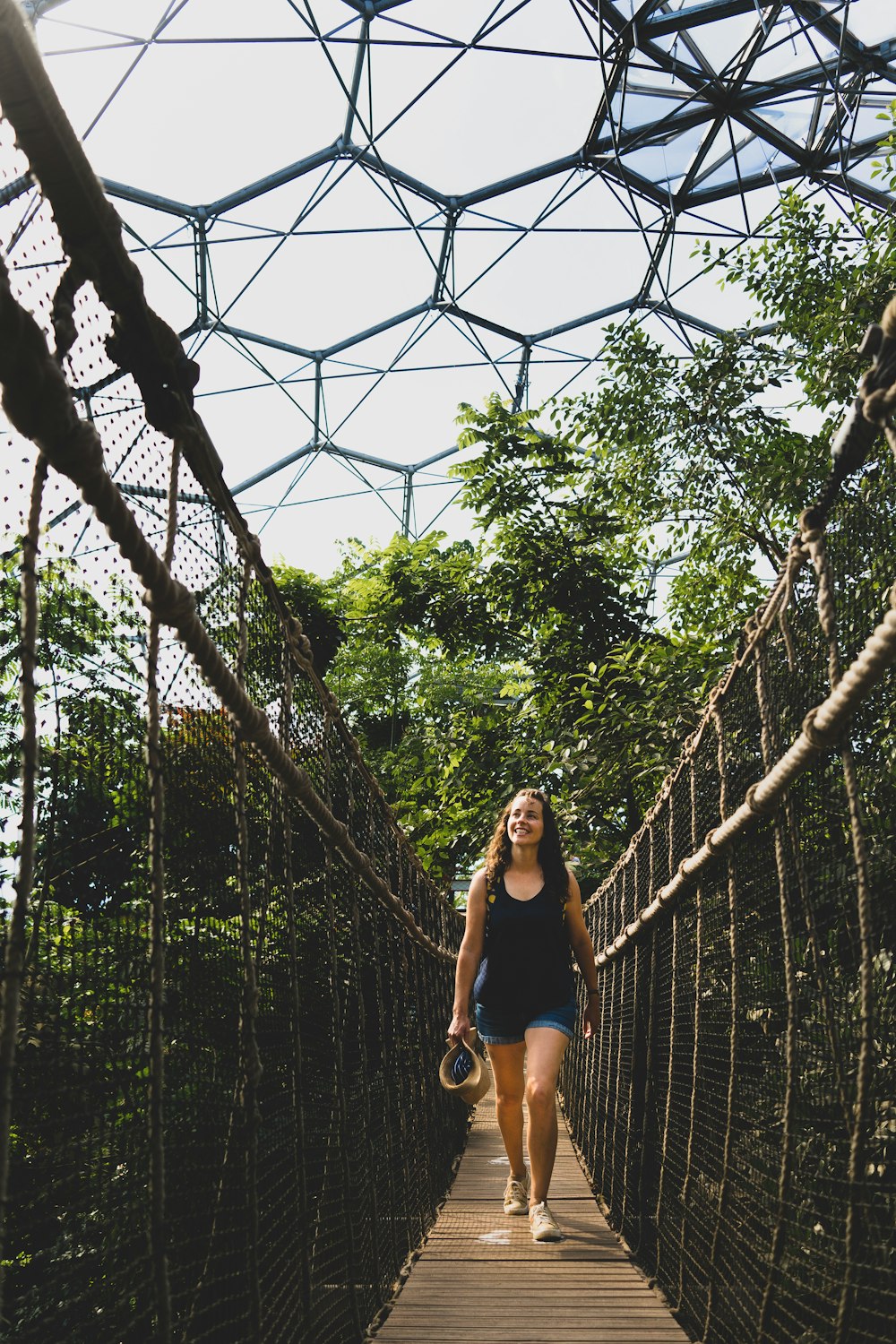Top 10 Amazing Facts about the Eden Project
The Eden Project is 4 located in Cornwall. The Project aims to visually tell the story of man’s dependence on plants.
Tim Smit conceived The Eden Project in 1994 and was also responsible for recovering the famous Lost Gardens of Heligan.
In the late 1990s, a small group gathered to talk about an idea to create a place like nothing anyone had ever seen before.
A place that explored our place in nature.
A demonstration of the difference that could be done if people got together.
Climate change is ruining our world and one of the best ways to remind humankind to reclaim the earth is The Eden Project.
They bought an exhausted, steep-sided clay pit 60 metres deep, with no soil, 15 metres below the water table and essentially gave it life.
With its bubble-like biomes and outstanding range of plants from around the globe, the Eden Project is a fantastic feat of biological engineering and is one of Cornwall’s premier attractions
The project opened to the public on 17th March 2001 and by June 2001 the millionth discoverer passed through the gates.
Read on to get to know the top 10 amazing facts about the Eden project
1. The Eden Project is Home to the World’s Largest Indoor Rainforest

Photo by Benjamin Elliott on Unsplash
Eden’s tropical biome houses an incredible selection of plants that make up the largest indoor rainforest in the world!
With over 1,000 varieties of plants, there’s plenty to see and experience. Venture up to the canopy walkway for stunning views from great heights.
The Rainforest Biome is the largest, warmest and (arguably) the most popular of the 2 domes.
Temperatures vary from 18*c-35*c, thus it is important to wear appropriately to combat the heat and humidity.
The Rainforest Biome is home to more than 1,000 different species of plants, so the time will fly by as you understand more about the origins of the plants and how important they are to humankind.
The vibrant colours on display are from all over the world, including South-East Asia, South America, West Africa and many different tropical islands.
2. The Eden Project Cost over £100 Million

Image by Roman Grac from Pixabay
Overall, the Eden Project cost £141 million to complete.
Government grants and loans from institutions like the Millennium Commission paid for the construction.
More funding came from the National Lottery and European regeneration funds.
The Millennium Commission weighed in with £37.5 million of Lottery funding to single Eden out as the ‘landmark’ project of the far South West.
Furthermore, their subsequent contributions brought the total to just over £56 million.
Other major sources of funding included the EU and Southwest Regional Development Agency (some £50 million between them, including £26 million towards capital funding from the EU) and £20 million in commercial loans.
3. The Eden Project Is a Boost to the Cornish Economy

Image by Nattanan Kanchanaprat from Pixabay
Since it opened in 2001, Cornwall’s Eden Project has established itself as one of the most popular tourist attractions in the UK.
Ever since it first opened, Eden says it made a conscious decision to source its supplies wherever possible from Cornish companies, be it food goods, plants, other retail items and even its electricity provider.
Today it continues to buy from no less than 3,000 Cornish firms.
The site has been a source of enormous economic revitalisation for Cornwall and the Southwest as a whole.
Eden Project has injected well over £1 billion into the local economy since its launch.
Additionally, there is the knock-on spending in the local economy by visitors who specifically go to Cornwall to visit the Eden Project.
The project contributed £700m to the Cornish economy in its first five years of opening.
As of 2021 The Eden Project has generated £2.2bn for the local economy, attracted 20 million visitors and has regenerated Cornwall.
4. The Eden Project Site is an Ideal Filming Location
The BBC series The Hitchhiker’s Guide to the Galaxy (1981) was filmed at the original site of the Eden Project.
The Eden Project is a world-class filming destination with locations and facilities for all levels of production.
With a vast indoor rainforest, a lush and varied selection of outdoor gardens and beautiful plants from the temperate regions in the Mediterranean Biome.
In 2002, after the Eden Project’s construction, it once again became a filming location for the James Bond film Die Another Day.
25 film productions have chosen the site as a location.
5. The Eden Project is Located in a Quarry
The Eden Project first opened in a disused china clay quarry in 2001. The focus was on big global challenges as defined by their localities, such as soil, water, food and biodiversity.
The Eden Project is a tourist attraction and charity. They aim to educate people about the relationship between human beings and plants.
To achieve that, the initiators of the project built two massive domes consisting of multiple interconnected domes that house numerous plant species.
Located in a reclaimed quarry in Cornwall, England. The complex consists of huge domes that look rather like massive igloo-shaped greenhouses.
The clay pit was in use for over 160 years.
6. The Eden Project biomes Inspired by Soap Bubbles

Image by jacqueline macou from Pixabay
Rather than ship in 90,000 tonnes of soil they wanted to create it in a way that showed environmental regeneration was possible.
The difficulty was creating biomes that would interlock across a constantly shifting landscape. Then they noticed how washing-up bubbles connect together and based the whole design on soap bubbles.
The hexagonal shape of the biome’s cells was based on soap bubbles. it was chosen for its ability to adapt to the uneven shape of the clay pit.
There are those who believe the covered biomes were inspired by the moon. The more the reason as to why you should visit, walk and discover more for yourself.
7. The Biomes are Made of a Special Plastic

Photo by fabian jones on Unsplash
Each cell is made up of three layers of ethylene tetrafluoroethylene copolymer (ETFE).
While ETFE is a type of plastic (which is a petroleum product), it is recyclable, light and durable.
If it rips, there is even special ETFE tape that can be applied so that a full panel does not need to be replaced.
It’s also cheaper, lighter and safer than glass. Once pieced together, the panels were sealed around their perimeter and inflated to create a large cushion.
Cushions act as a thermal blanket and keep conditions inside the biome conducive to housing flora.
ETFE is lighter than glass but also strong enough to withstand the weight of a car. It also lets in UV light for the plants inside.
8. Dance away at the Eden Sessions

Image by Ron Porter from Pixabay
The Eden Project also hosts musical performances and concerts.
Since the first show, the Eden Sessions have welcomed the likes of Oasis, Amy Winehouse, Kylie, Elton John, Snow Patrol, Kaiser Chiefs and Björk.
The Daily Telegraph described the Sessions as ‘Magical… half Glastonbury, half Glyndebourne’.
Thanks to its unique venue, the Eden Project is also a popular place to host musical performances, with world-renowned musicians performing in these ‘Eden Sessions’.
2022 headliners are My Chemical Romance, Noel Gallagher High Flying Birds, Nine inch Nails, Diana Ross, Bryan Adams and Stereophonics.
9. 230 Miles of Scaffolding were Used in Construction

Image by PublicDomainPictures from Pixabay
The Eden project made the Guinness Book of Records for the most amount of scaffolding: 230 miles.
It was hard for people to build a home extension for a while, because so much scaffolding was down at Eden.
The structure involved loads of trusses, and driving it all down the A30 would have meant road closures and massive lorries.
So they were made into smaller bits, like a huge Meccano set and driven down in small trucks.
It took about 2.5 years to construct the massive project.
10. The Eden Project is home to England’s Longest and Fastest Zip Wire
Although the vast array of plants and spectacular gardens are the main draw of the Eden Project, a stroll in greenery is not all.
Experience Skywire, England’s longest and fastest zip wire or swing into space on this GIANT cliff swing!
The 660m long zip wire that takes you to speeds of 60 mph is sure to provide a thrill.
There are other activities like SkyTrek aerial trekking course, gravity giant swing, the drop leap of faith and big air base jump.
With no building of this scale in the world, at the time a global audience referred to it as the eighth wonder of the world!
It was hugely popular from the start, attracting over 1 million visitors in its first four months.
The giant crater that it sits in, the enormous rainforest & Mediterranean biomes and the outdoor gardens are breathtaking and a “must-see” for everyone.
Planning a trip to Paris ? Get ready !
These are Amazon’s best-selling travel products that you may need for coming to Paris.
Bookstore
- The best travel book : Rick Steves – Paris 2023 – Learn more here
- Fodor’s Paris 2024 – Learn more here
Travel Gear
- Venture Pal Lightweight Backpack – Learn more here
- Samsonite Winfield 2 28″ Luggage – Learn more here
- Swig Savvy’s Stainless Steel Insulated Water Bottle – Learn more here
Check Amazon’s best-seller list for the most popular travel accessories. We sometimes read this list just to find out what new travel products people are buying.













